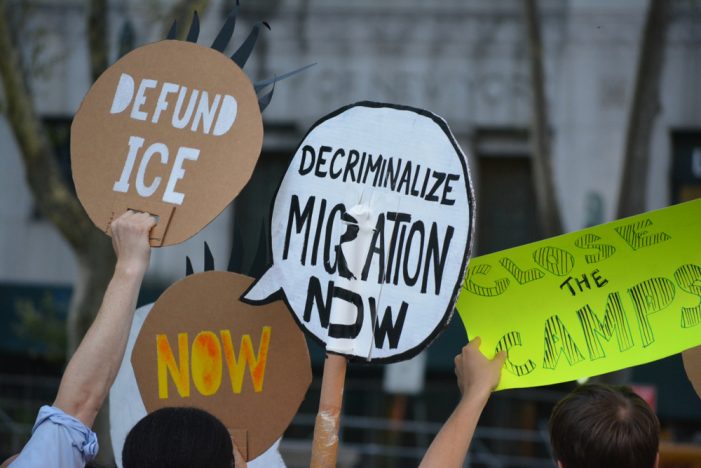By Mary Campbell | Editorial credit: Christopher Penler / shutterstock.com
In recent months, a stark and controversial image has come to symbolize the Trump administration’s hardline immigration agenda: masked, often plainclothes Immigration and Customs Enforcement (ICE) officers conducting arrests in public spaces, courthouses, workplaces, and even neighborhoods—without identifying themselves or presenting a badge.
This tactic, described by immigration advocates as clandestine and deeply unsettling, has become increasingly common since the Trump-era escalation of immigration enforcement. Critics argue that such operations blur the line between law enforcement and intimidation, eroding public trust and spreading fear among immigrant communities—many of whom now feel unsafe even in places previously considered protected, such as schools, places of worship, and courthouses.
The Rise of Masked Enforcement
Under policies aggressively expanded during Donald Trump’s presidency, ICE was granted broader latitude to arrest undocumented immigrants regardless of criminal history. That expansion included ramped-up workplace raids, “silent” arrests during routine traffic stops, and surveillance of community events.
What distinguishes the new wave of enforcement is the anonymity of the officers. Reports from cities across the U.S.—from New York to Los Angeles—have documented ICE agents operating without uniforms, often wearing balaclavas or face coverings, and not clearly identifying themselves before detaining individuals.
In some cases, the lack of identification has led to confrontations and confusion, with bystanders unsure whether they are witnessing a federal arrest or an unlawful kidnapping.
“We’re witnessing the militarization of immigration enforcement,” said a civil rights attorney in New York. “Individuals are being taken off the streets without clear evidence that it’s a lawful action by a federal agency. This isn’t how law enforcement should function in a democracy.”
Arrests at Courthouses and Public Spaces
Courtrooms, once considered safe spaces for due process, have become a prime target for ICE operations. Immigrants appearing in court for unrelated civil or criminal matters have been intercepted at courthouse entrances and arrested upon exiting hearings. The practice has drawn harsh criticism from judges, attorneys, and human rights groups who argue it discourages immigrants from accessing justice.
“The idea that someone could be arrested simply for appearing in court sends a chilling message,” said Judge Ricardo Muñoz of California’s Superior Court. “It undermines the very foundation of our legal system.”
In many cases, ICE agents have reportedly used unmarked vehicles, followed individuals for days, and conducted early morning raids with little or no warning.
The Justification for Masks
Acting ICE Director Todd Lyons has defended the use of masks, claiming that the anonymity is necessary to protect officers and their families. “I am sorry if people are offended by them wearing masks, but I’m not going to let my officers and agents go out there and put their lives on the line, and their family on the line, because people don’t like what immigration enforcement is,” Lyons said during a recent briefing.
According to former ICE officials, the practice of masking agents may have begun around March of 2025. Scott Shuchart, a senior ICE official during the Biden administration, believes that it was around this time when federal immigration officers, operating without visible identification, began targeting international students on campuses or near their homes. This surge in masked operations coincided with the Trump administration’s campaign against pro-Palestinian student activists and critics of Israel’s policies, further fueling the debate about the motivations behind the tactic.
“The way that they’re carrying on without any visible identification—even that they’re law enforcement, much less what agency they’re with—really is unprecedented at this scale, and I think it’s very dangerous,” Shuchart said.
“Setting Ourselves Up for a Kind of Vigilante Problem”
There is no federal policy dictating when officers can or should cover their faces during arrests. Historically, law enforcement officers have almost always concealed their faces only during undercover operations to protect the integrity of ongoing investigations, experts told CNN.
While some experts acknowledge the need to protect agents from potential retribution, especially in a climate where technology and social media have made it easier to track and expose officers’ personal information, critics argue that the practice has gone too far. Many controversial enforcement actions have been conducted in public spaces, such as residences and courthouses—places where the anonymity of masked agents raises concerns about due process and accountability.
“We’re setting ourselves up for a kind of vigilante problem,” warned Scott Shuchart, a former senior ICE official. “There are no clear boundaries or guidelines, and this kind of enforcement opens the door for abuse. It’s one thing to protect agents, but it’s another to let them operate without any accountability or transparency.”
Critics have also pointed out the glaring irony in the Trump administration’s approach to masks. While the president has repeatedly called for bans on masks during protests—arguing that demonstrators who hide their identities are up to something suspicious—the same administration is allowing federal agents to wear face coverings to detain immigrants.
Just a week ago, after protests over immigration raids turned violent in Los Angeles and U.S. troops were deployed to quell unrest, President Donald Trump took to social media to vow a ban on masks at protests. “MASKS WILL NOT BE ALLOWED to be worn at protests. What do these people have to hide, and why???” he posted on Truth Social.
The contradiction has not gone unnoticed. While the administration pushes for transparency in protest movements, it has permitted a shadowy, unaccountable form of immigration enforcement that many see as undermining the rule of law.
Legal and Legislative Pushback
In response to growing concern, several states—including New York, Washington, and California—have passed laws limiting ICE access to courthouses and mandating identification by federal agents during arrests. Federal courts have also taken up cases challenging the constitutionality of such enforcement methods.
Still, for many immigrant communities, the damage is already done. “My son was taken by someone in a mask—we didn’t even know it was ICE until days later,” said a Venezuelan mother in Texas who asked to remain anonymous. “We thought he was kidnapped.”
As immigration policy continues to be a contentious issue in the post-Trump era, the image of masked federal agents making silent arrests remains a powerful—and polarizing—symbol of the lengths to which the former administration went in pursuit of its crackdown.

